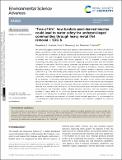| dc.description.abstract | The abnormally gigantic baobab tree (Adansonia digitata) is often referred to as the “Tree of Life” due to its
ability to provide food, water, shelter, and traditional medicine for both humans and animals in arid regions.
This special tree is a landmark of Africa's savanna and has attracted the attention of the global research
community. This study investigated the potential of biochar derived from baobab seeds for the removal
of metallic ions from groundwater. The biochar, prepared at 700 °C, exhibited a unique surface
morphology with deep voids and varied structures, suggesting increased surface area and favorable
conditions for adsorption. SEM-EDX analyses confirmed the elemental composition, with carbon being
the predominant element. Furthermore, XRD analysis indicated an amorphous structure, enhancing
adsorption capacity for heavy metal ions. Additionally, BET analysis revealed a significant surface area
(1386.704 m2 g−1
) and well-defined pores, emphasizing the material's potential for metallic ion removal.
The metallic ion of choice for this research was Fe because of its abundance in the study area and the
community's need for affordable technology for discoloration of reddish-brown groundwater caused by
Fe ion presence. In the batch mode equilibrium studies, the effect of pH, contact time, adsorbent
particle size, adsorbent dose, solution temperature, and initial metal ion concentration was investigated.
Optimal pH metallic ion removal occurred under neutral pH conditions, with higher removal efficiency
observed at increased contact time (up to 120 min) and adsorbent doses. Adsorption isotherm modeling
using Langmuir and Freundlich models indicated favorable adsorption, with the Freundlich model
providing a slightly better fit. In conclusion, baobab seed-derived biochar demonstrated promising
potential as an efficient and sustainable adsorbent for metal ion removal from groundwater. Further
exploration, including the development of activated carbon and field applications, is recommended for
a comprehensive understanding and practical optimization of this material's capabilities for metal ion
removal. | en_US |

